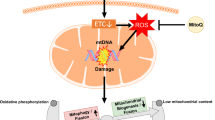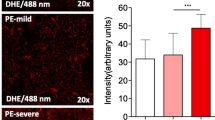Abstract
Objective
Placental production of lipid peroxides is abnormally increased in preeclampsia. The reason for this is not known, but if placental antioxidant enzymes were deficient, lipid peroxides would increase unchecked. In this study, we measured 1) enzyme activities of superoxide dismutase (CuZn-SOD), catalase, and glutathione peroxidase (GSH-Px) and tissue levels of vitamin E, and 2) mRNA expression of CuZn-SOD, catalase, and GSH-Px in normal and preeclamptic placentas.
Methods
Placental tissues were obtained from normal (n = 16) preeclamptic (n - 12) pregnancies immediately after delivery. Tissue pieces were frozen in liquid nitrogen and stored at −80C until assayed. The enzyme activities of CuZn-SOD, catalase, and GSH-Px and the levels of vitamin E were determined by spectrophotometric assays. Messenger RNA expression of CuZn-SOD, catalase, and GSH-Px was determined by Northern blot analysis.
Results
The activities of CuZn-SOD and GSH-Px and the tissue levels of vitamin E were significantly lower in preeclamptic placentas than in normal placentas (CuZn-SOD: 1.13 ± 0.49 versus 3.71 ± 0.71 V/mg protein, P <.01; GSH-Px: 0.18 ± 0.01 versus 0.26 ± 0.02 U/mg, P <.01; vitamin E: 0.08 ± 0.01 versus 0.18 ± 0.01 µg/mg, mean ± standard error, P <.001), whereas the activity of catalase was significantly higher (93 ± 3 versus 83 ± 2 U/mg, P <.05). Relative mRNA expression of CuZn-SOD and GSH-Px was significantly lower in preeclamptic than normal placentas (V < 0.05), but there was no significant difference for catalase (P >.4).
Conclusions
1) Activities of CuZn-SOD and GSH-Px and the tissue levels of vitamin E are significantly lower in preeclamptic than in normal placentas. 2) Activity of catalase is significantly higher in preeclamptic than in nortnal placentas. 3) Messenger RNA expression for CuZn-SOD and GSH-Px is lower in preeclamptic placentas. We speculate that decreased antioxidant activity may result in increased lipid peroxide levels in preeclamptic placentas. (J Soc Gynecol Invest 1996;3:179-84)
Similar content being viewed by others
References
Sekiba K, Yoshioka T. Changes of lipid peroxidation and superoxide dismucase activity in the human placenta. Am J Obstet Gynecol 1979;135:368–71.
Takehara Y, Yoshioka T, Sasaki J. Changes in the levels of lipoperoxide and antioxidant factors in human placenta during gestation. Acta Med Okayama 1990;44:103–11.
Wang Y, Walsh SW, Kay HH. Placental lipid peroxides and thromboxane are increased and prostacyclin is decreased in women with preeclampsia. Am J Obstet Gynecol 1992;167:946–9.
Walsh SW, Wang Y. Trophoblast and placental villous core production of lipid peroxides, thromboxane, and prostacyclin in preeclampsia. J Clin Endocrinol Metab 1995;80:1888–93.
Walsh SW, Wang Y. Deficient glutathione peroxidase activity in preeclampsia is associated with increased placental production of thromboxane and lipid peroxides. Am J Obstet Gynecol 1993;169:1456–61.
Paoletti F, Mocali A. Determination of superoxide dismutase activity by purely chemical system base on NAD(P)H oxidation. Methods Enzymol 1990;186:209–20.
Cohen G, Dembiec D, Marcus J. Measurement of catalase activity in tissue extracts. Anal Biochem 1970;34:30–8.
Desai ID. Vitamin E analysis methods for animal tissues. Methods Enzymol 1984;105:138–47.
Chomczynski P, Sacchi N. Single-step method of RNA isolation by acid guanidinium thiocyanate-phenol-chloroform extraction. Anal Biochem 1987;162:156–9.
Stamler FW. Fatal eclamptic disease of pregnant rats fed anti-vitamin E stress diet. Am J Path 1959;35:1207–31.
Spitz B, Deckmyn H, Van Bree R, Pijnenborg R, Vermylen J, Van Assche FA. Influence of a vitamin E-deficient diet on prostacyclin production by mesometrial triangles and aortic rings from nondiabetic and diabetic pregnant rats. Am J Obstet Gynecol 1985;151:116–20.
Wang Y, Walsh SW, Guo J, Zhang J. The imbalance between thromboxane and prostacyclin in preeclampsia is associated with an imbalance between lipid peroxides and vitamin E in maternal blood. Am J Obstet Gynecol 1991;165:1695–700.
Wisdom SJ, Wilson R, McKillop JH, Walker JJ. Antioxidant systems in normal pregnancy and in pregnancy-induced hypertension. Am J Obstet Gynecol 1991;165:1701–4.
Mikhail MS, Anyaegbunam A, Garfinkel D, Palan PR, Basu J, Romney SL. Preeclampsia and antioxidant nutrients: Decreased plasma levels of reduced ascorbic acid, α-tocopherol, and beta-carotene in women with preeclampsia. Am J Obstet Gynecol 1994;171:150–157.
Chen G, Wilson R, Gumming G, Walker JJ, Smith WE, Mc-Killop JH. Prostacyclin, thromboxane and antioxidant levels in pregnancy-induced hypertension. Eur J Obstet Gynecol Reprod Biol 1993;50:243–50.
Uotila JT, Tuimala RJ, Aarnio TM, Pyykko KA, Ahotupa MO. Findings on lipid peroxidation and antioxidant function in hypertensive complications of pregnancy. Br J Obstet Gynaecol 1993;100:270–6.
Cooper DW, Brennecke SP, Wilton AN. Genetics of preeclampsia. Hypertens Pregn 1993;12:1–23.
Chen G, Wilson R, Boyd P, et al. Normal superoxide dismutase (SOD) gene in pregnancy-induced hypertension: Is the decreased SOD activity a secondary phenomenon? Free Radic Res 1994;21:59–66.
Pigeolet E, Corbisier P, Houbion A, et al. Glutathione peroxidase, superoxide dismutase, and catalase inactivation by peroxides and oxygen derived free radicals. Mech Ageing Dev 1990;51:283–97.
Blum J, Fridovich I. Inactivation of glutathione peroxidase by superoxide radical. Arch Biochem Biophys 1985;240:500–8.
Lu D, Maulik N, Moraru H, Kreutzer DL, Das DK. Molecular adaptation of vascular endothelial cells to oxidative stress. Am J Physiol 1993;264:C715–22.
Shull S, Heintz NH, Periasamy M, et al. Differential regulation of antioxidant enzymes in response to oxidants. J Biol Chem 1991;266:24398–403.
Author information
Authors and Affiliations
Additional information
Supported by HD 20973 from the National Institute of Child Health and Human Development.
Rights and permissions
About this article
Cite this article
Wang, Y., Walsh, S.W. Antioxidant Activities and mRNA Expression of Superoxide Dismutase, Catalase, and Glutathione Peroxidase in Normal and Preeclamptic Placentas. Reprod. Sci. 3, 179–184 (1996). https://doi.org/10.1177/107155769600300404
Published:
Issue Date:
DOI: https://doi.org/10.1177/107155769600300404




